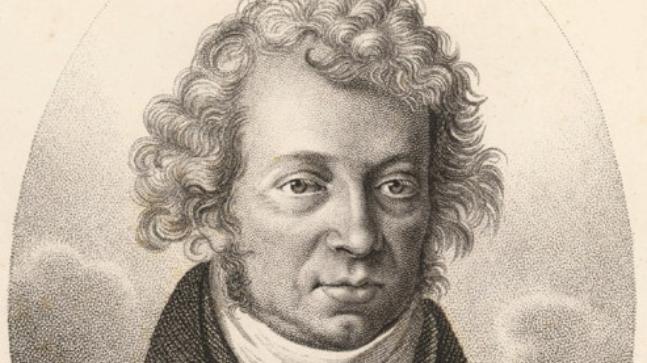The answer is a French physicist and mathematician of the eighteenth and nineteenth centuries who was one of the pioneers in the study of electromagnetism.
André-Marie Ampère was born on 20 January 1775 to Jean-Jacques Ampère, and Jeanne Antoinette Desutières-Sarcey Ampère at Poleymieux-au-Mont-d’Or near Lyon, Fance.
As a wealthy businessman Andre-Marie’s father had an extensive library. He believed that his son should educate himself as that was a contributing factor of genius and so Andre-Marie spent his days in his father’s library. His interests ranged from Science to Poetry, from History to Mathematics and Philosophy and he developed into a true polymath.
During the French Revolution from 1789 to 1799 Ampère’s father was made a justice of the peace, by the revolutionary government, in a small town near Lyon. However, during the Jacobin purges, Ampere’s father resisted the extreme policies and as a result was sent to the guillotine on 24 November 1793.
Ampère took his first regular job in 1799 as a mathematics teacher, which gave him the financial security to marry Julie Carron, whom he had met three years earlier, and father his first child, who he named Jean-Jacques in memory of his father.
In 1802, Ampère was appointed a professor of physics and chemistry at the École Centrale in Bourg-en-Bresse, which necessitated him leaving his wife, who was very ill, and his three-year-old son Jean-Jacques in Lyon. Sadly, his wife died in July 1803.
The following year Ampère moved to Paris, to take on a tutoring post at the newly built École Polytechnique.
In 1809 Ampère was appointed a professor of mathematics at the school, a position he would keep for 19 years. Alongside teaching Mathematics at the École Polytechnique, in 1819 and 1820 Ampère also lectured courses in philosophy and astronomy, at the University of Paris. His work was so admired that in 1824 he was elected to the prestigious chair in experimental physics at the Collège de France.
Following the discovery that a magnetic needle is affected by an electric current placed near it, as described by Danish physicist Hans Christian Ørsted, Ampère began developing a theory to understand the relationship between electricity and magnetism. Using Ørsted’s experimental work as a base to explore further, Ampère showed that two parallel wires carrying electric currents attract or repel each other, depending on whether the currents flow in the same or opposite direction. Respectively. This then was the foundation of electrodynamics.
In 1827, the importance of Ampère’s work was recognised when he was elected a Foreign Member of the British based Royal Society.
Following his death in 1836, Andre-Marie Ampere has been immortalised by many streets, squares, schools and even a Lyon metro station being named after him.
Finally at an international convention, signed at the 1881 International Exposition of Electricity, established the ampere as one of the standard units of electrical measurement. The Amp was created.


Leave a Reply